
One picture says more than 1000 words!
RADIO COMMUNICATION SYSTEM FOR
EXTRATERRESTRIAL CONTACTS
(2006)
KLIK HIER VOOR DE NEDERLANDSE VERSIE
Why did we not make that radio contact?
We should communicate with pictures!
When we want to design a radio communication system for radio contact with other civilizations in the universe, it has to be suitable to transmit pictures. One picture says more than 1000 words!

One picture says more than 1000 words!
An efficient transmission system.
Very efficient radio communication systems do transmit at maximum power and at a fixed frequency (tone height) during a fixed short time period (i.e 0.1 second). That fixed frequency (stable tone height) during fixed time periods is necessary to get the signals out of the noise with very narrow bandwidth techniques.
The system we are going to design here can work with signals that are 10 dB above the noise. That is much better than old analog systems.
The principle.
If we want to transmit a picture as a series of tones with fixed time length, then we have to digitize it! Therefore, the picture is composed of pixels just as with a computer screen. Every pixel is transmitted as a fixed tone with a fixed time length of 1/8 second. The tone height (or frequency of the signal) defines the brightness of the pixel. Black is a tone of 32 Hz, white level is a tone of 96 Hz. The receiver is in principle not one but a number of separate receivers, each with a bandwidth of 8 Hz and tuned to 32; 40; 48; 56; 64; 72; 80; 88 and 96 Hz. One of the receivers will measure the highest level. Which receiver that is, determines the brightness of the pixel. As every receiver does have a small bandwidth of only 8 Hz, the system will be very sensitive while it is possible to transmit 8 pixels per second. Of course it are not really so many receivers. It is an A/D converter with a computer that simulates the receivers by means of calculations.
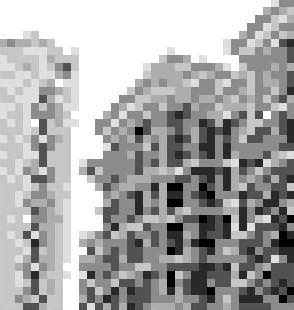
A picture has to be composed of pixels
to be able to transmit it very efficiently.
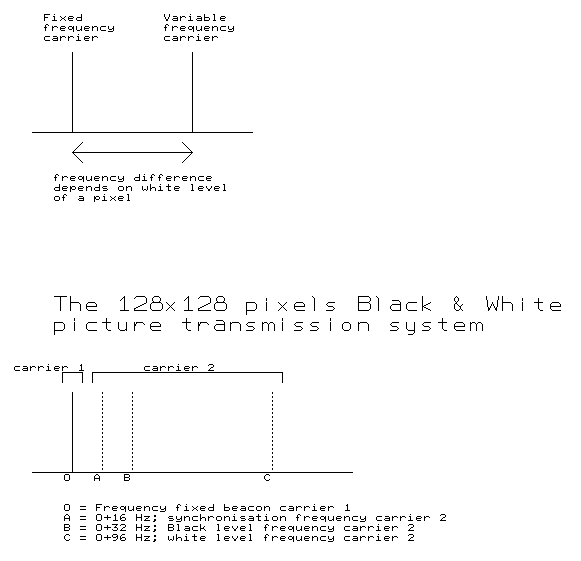
The communication system for exchanging pictures with
another civilization, a picture says more than 1000 words!
System line signals.
The synchronisation line is followed by 3 system lines that will indicate the black level, the white level and the pixel rate (pixels per second) The first line consists of 128 pixels with a black level. The second line consists of course of 128 pixels with a white level. The third system line is 64 pairs of black and white pixels (one black pixel followed by one white pixel).
After the system lines there are the 128 lines with 128 pixels with picture information plus 1 synchronisation pixel at the end of each line. The picture ends with a synchronisation line to clearly indicate the end of a picture transmission.
Simple to recognize as a transmission of a picture.
Every civilization will recognize the above described system as a transmission of a picture. The synchronisation signals do clarify this even more. The system is also composed as a multiple of 2. We will start with square sized pictures of 128x128 pixels. But other formats can also be transmitted. The synchronisation signals do indicate the start and end of a picture and the end of a line with pixels.
 Beacon carrier 1 and carrier 2 at synchronisation position |
 Beacon carrier 1 and carrier 2 at black level position |
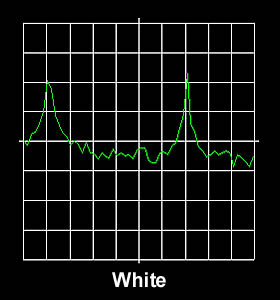 Beacon carrier 1 and carrier 2 at white level position |
Easily to find in the radio spectrum.
Carrier 1 transmits continuously on a fixed frequency. So it is also a beacon. It is possible to search for such a beacon signal with a much narrower bandwidth than 8 Hz. That is why it will be even more above the noise and more noticed. We will monitor a star with possible planets with two radio telescopes from two different places on earth. When such a beacon signal is detected by both radio telescopes and if it has a dopplershift caused by the rotation of the earth, it will be a signal from space! Very simple!
More pixels.
A picture of 128x128 pixels is quite small but contains already much information. We can also transmit 16 pixels per second, The 8 Hz bandwidth and the frequency offsets for synchronisation and black level are doubled. The sensitivity is reduced a little but the resolution is much better then. When we also do increase the frequency difference between the black and white level, the picture will also contain more black and white levels. A picture of 256x256 pixels is already much better. We do always transmit the 128x128 pixel pictures. If we want to transmit other pictures with a higher resolution, we will do that with an extra transmitter on an adjacent frequency.
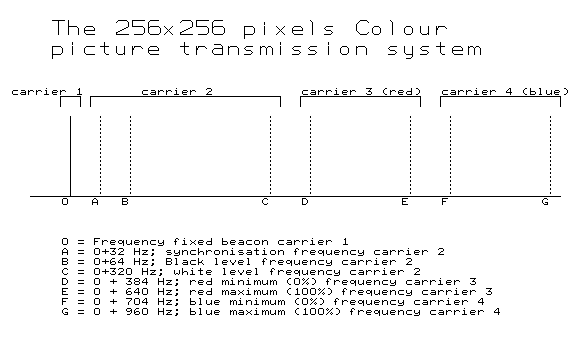
The communication system for exchanging colour pictures
with another civilization. Many variations are possible!
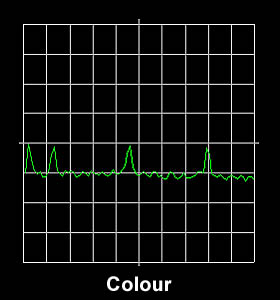
The beacon carrier, the black and white carrier
and the two carriers for red and blue
How can we find each other?
We have chosen already for the frequency range from 1000 to 2000 MHz. The parabolic antennas do see only a very small part of the sky. Just pointing the antenna to a direction and hope that there is someone that has pointed its antenna to us is useless. We and they have to look for certain stars that may have possible planets for a civilization. Not all stars are suitable. Many have for example too much temperature variations. There are approximately 100 interesting stars in a range of 30 to 50 lightyears.
The receivers
We are looking for a beacon transmission of a constant carrier of a possible civilization. Two radio telescopes on different places on earth are pointed towards a star at the same time. When both telescopes do receive this beacon signal and they do see the dopplershift in the reception frequency caused by the rotation of the earth, then it is a signal from space. With four radio telescopes it is possible to monitor all the 100 selected stars every day. An extra antenna is necessary to investigate certain signals. Totally we do need 5 radio telescopes with a diameter of 100 meter for the reception of signals.
The transmitters
A transmission has to be quite long, at least a few days. When a beacon transmission is found, there has to be sufficient time to decode it. Then there has to be enough time left to decode many pictures. In 3 days, we can tramsmit already many pictures to a civilization. With 5 radio telescopes of 100 meter diameter, we can do that a few times per year per selected star. Of course, we do not always transmit the same pictures so that they will continuously receive new information. The transmit frequency is corrected for the rotation of the earth (and they will do that for the rotation of their planet) to avoid problems with the doppler shift at the reception side.
How much money
One billion euros per radio telescope, so 10 billion euros. That seems a lot. But it is only a minor part of the defense budget in the world. So money is not a problem.
Some examples of pictures
Here some examples of pictures as they are sent with the described system. The 256x256 colour pictures do give a good impression, the 128x128 pixels black and white pictures are not so good but make it already very clear that it is a civilization that seems to be quite similar to us!
| Examples of pictures we will transmit to other civilizations | ||
|
128x128 pixels 8 black/white levels |
256x256 pixels black/white |
256x256 pixels colour |
|
8 Pixels/s Transmit time 34 minutes 41 pictures per day |
16 Pixels/s Transmit time 68 minutes 21 pictures per day |
16 Pixels/s Transmit time 68 minutes 21 pictures per day |

|
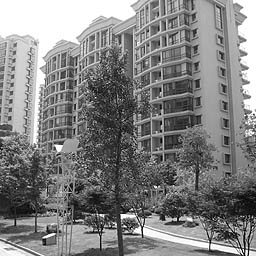 Here we live |
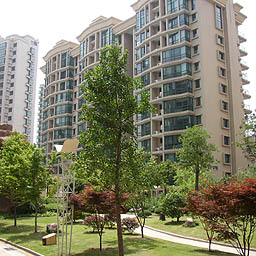 Here we live |
|
The 128x128 pixel picture shows already that there are buildings and trees. A picture says more than 1000 words. We can tell each other a lot with pictures! |
||

|
 Our nicest buildings |
 Our nicest buildings |
|
One of our nicest buildings. Of course we are very proud of them and like to show them! The 256x256 colour pictures are much better than the 128x128 black and white pictures |
||
Above and below, left and right, sizes.
Here below a picture of the closest star nebula that consists of 400.000.000.000 stars! We will see it exactly the same way as they do because it is so far away. When they should send us this picture, we will know what is left and right. Sizes of certain items can be indicated by drawing a sine in the picture. The wave length is of course the wave length of the transmission. A picture with binary numbers (0000, 0001, 0010, 0011, 0100 etc.) with the associated numbers will also be understood very well by them.
